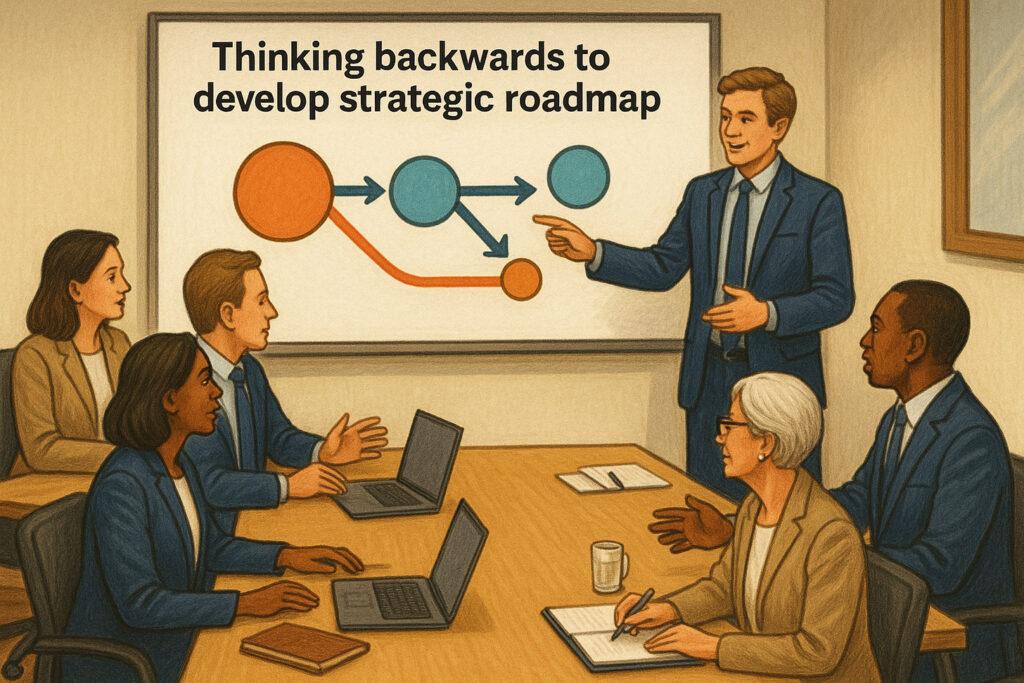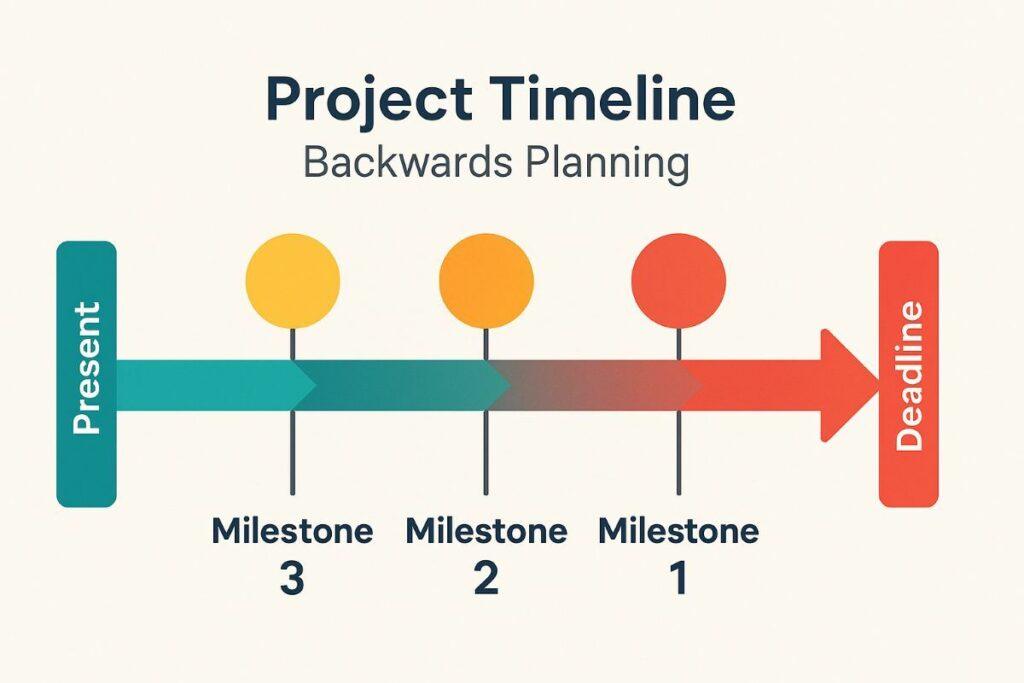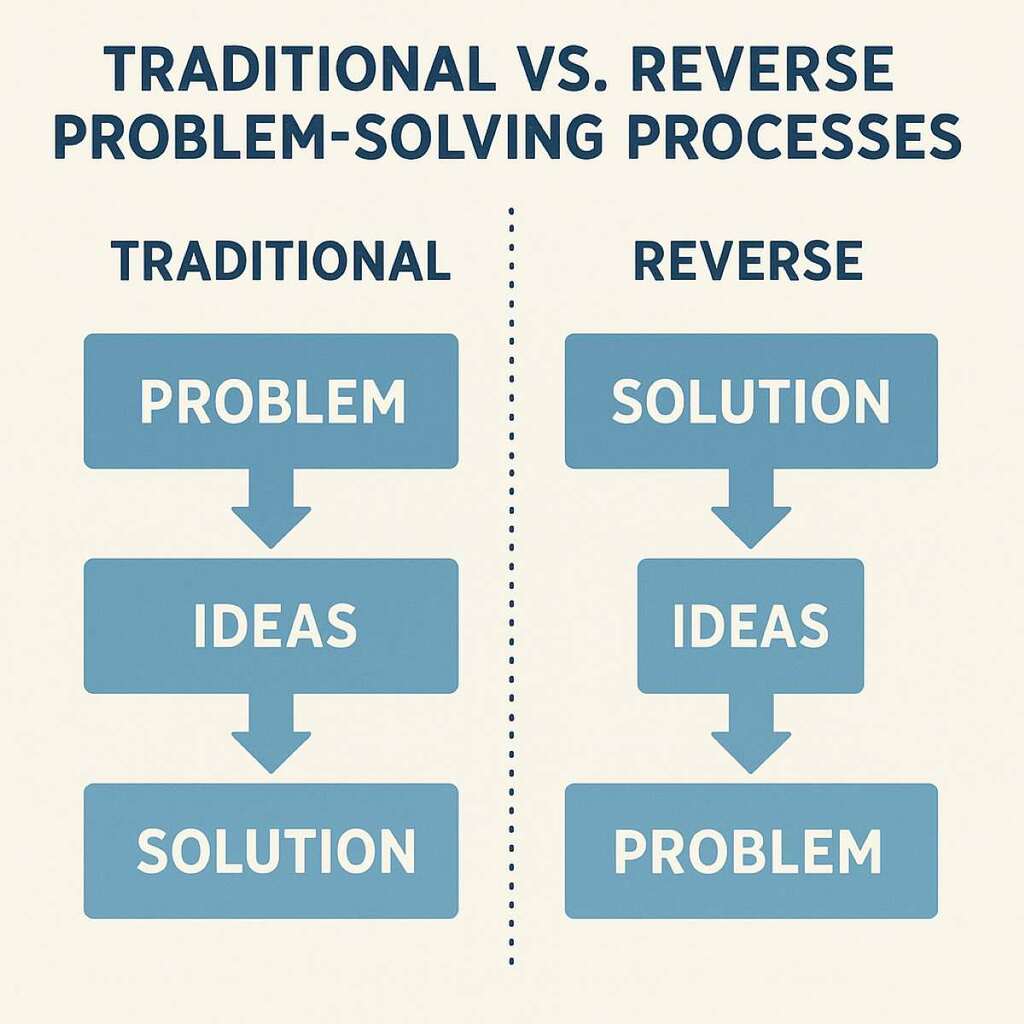Amazon’s “Working Backwards” method is a great example. NASA also plans its missions this way. And tech breakthroughs often come from reverse-engineering. The idea is simple: know what success looks like, then figure out how to get there.
This approach helps avoid decision fatigue. It also leads to creative solutions that might not be seen by traditional thinking. In this article, we’ll show you how to use thinking backwards to solve problems and achieve goals.
Understanding the Power of Thinking Backwards
Traditional vs. Reverse Problem-Solving Process
Thinking backwards, also known as retrograde analysis or reverse engineering, flips our natural problem-solving instinct on its head. Our brains are wired to think linearly – from problem to solution. This forward approach often leads us down predictable paths with limited outcomes.
When we think backwards, we disrupt this pattern. We start by clearly defining success, then work in reverse to identify the necessary steps to achieve it.
This method mirrors how chess masters analyze positions or how engineers deconstruct complex products to understand their components.
Albert Einstein recognized this approach’s value when he said, “We cannot solve our problems with the same thinking we used when we created them.” By reversing our thought process, we access different neural pathways and discover innovative solutions that might otherwise remain hidden.

The Cognitive Science Behind Thinking Backwards
Modern neuroscience shows that thinking backwards uses different brain paths than planning ahead. It doesn’t rely on the default mode network (DMN) for imagining scenarios. Instead, it taps into the brain’s executive function areas, like the prefrontal cortex. These areas help with planning and stopping thoughts.
A 2021 study in Nature Communications found that thinking backwards helps solve problems better. People who thought backwards did 23% better on logic tasks. They also got rid of wrong options faster. This is how chess experts and top project managers work.
Thinking backwards is more than just a creative trick. It’s a proven method that matches how our brains tackle tough challenges.
3 Practical Applications of Thinking Backwards
The thinking backward approach has proven effective across various domains, helping individuals and teams move forward by recognizing patterns and positioning themselves for success each day.
Elon Musk’s Use of First Principles and Backward Strategy
Elon Musk often talks about “first principles thinking.” This is a way of thinking that involves starting from the end goal and working backward. Instead of copying others, Musk breaks problems down to their basic truths.
He then reconstructs them from the end goal back to the present. This is how SpaceX designed reusable rockets. They started with the desired outcome and questioned every assumption along the way.
For example, Musk didn’t accept the high cost of aerospace parts. He asked, “What should the raw materials cost if we built it from scratch?” This way of thinking led to dramatic cost reductions and rapid innovation.
It’s a real-world example of backward reasoning at scale.
Here are three practical applications that demonstrate its versatility and power:
1. Business Strategy Development

By starting with the end user experience, teams can work backwards to determine what features are truly necessary, what problems need solving, and what resources are required. This eliminates feature bloat and ensures the final product delivers genuine value.
2. Project Management and Planning

Timeline Inversion Framework for Project Planning
In project management, backwards planning (also called reverse scheduling) starts with the delivery date and works backwards to determine when each task must begin.
This approach reveals dependencies that might be missed in forward planning and creates more realistic timelines.
For example, when planning a product launch, start with the launch date and work backwards through marketing preparation, production, testing, development, and initial concept. This in turn highlights critical paths and potential bottlenecks before they become problems.
3. Personal Goal Achievement

For instance, if your goal is running a marathon, start by envisioning crossing the finish line. Then work backwards: What weekly mileage would you need the month before?
What about six months before? What dietary changes, strength training, and recovery practices would support this goal? This creates a concrete roadmap rather than a vague aspiration.
Why Forward Thinking Often Fails

Most strategies fail not because the goal is wrong—but because the sequence of execution is off. Forward thinking can lead to too much planning, adding unnecessary features, and wasting time. This happens because we start with what we have instead of what we want to achieve.
This mistake is known in behavioral economics as means-driven bias. We tend to focus on what we know how to do, not what will actually work.
Backward thinking changes this. It helps us see what’s truly important and what steps we might have missed or not prioritized right.
Looking at failed projects from the back, teams often find they never really defined success. Or they didn’t create a clear path to get there.
Case Study: Solving Complex Problems Through Reverse Engineering
The Challenge
A software development team was struggling with an application that had become increasingly complex and difficult to maintain. New features took months to implement, and each update introduced new bugs.
The team had been trying to improve the situation by adding more developers and implementing better testing procedures, but progress remained slow.
The Solution
Instead of continuing to patch the existing system, the team applied thinking backwards. They defined what an ideal, maintainable application would look like, including specific performance metrics, architecture principles, and user experience goals. Then they worked backwards to identify what needed to change in their current system.
This reverse perspective revealed that their monolithic architecture was the root cause of their problems. Rather than continuing to add features to the existing codebase, they needed to refactor toward a microservices architecture.
By starting with the end goal, they identified a solution that wouldn’t have been apparent through incremental improvements.
The team created a transition plan that allowed them to gradually move to the new architecture while continuing to support existing customers. Within six months, development speed had doubled, and bug reports had decreased by 70%.
Step-by-Step Guide to Implementing Thinking Backwards

Outcome-First Decision Process Flowchart
Ready to apply thinking backwards to your challenges? Follow these steps to implement this powerful approach:
1. Define Success with Clarity
Start by defining what success looks like in specific, measurable terms. Avoid vague goals like “improve performance” in favor of specific outcomes like “reduce page load time to under 2 seconds.”
The more precisely you can envision the end state, the more effective your backwards planning will be.

2. Identify the Final Step
Ask yourself: “What would be the very last action taken before achieving success?” This might require brainstorming and creative thinking, as it’s not always obvious.
For a product launch, the final step might be “send announcement email to customers.” For a fitness goal, it might be “complete final training run before race day.”
3. Work Backwards Systematically
Once you’ve identified the final step, ask what needs to happen immediately before that. Then what needs to happen before that step? Continue this process, creating a reverse chain of actions leading from your goal back to your current position.

4. Map Dependencies and Resources
As you work backwards, identify dependencies between steps and the resources required for each. This reveals potential bottlenecks and helps prioritize actions.
Ask: “What must be in place before this step can happen?” and “What resources (time, money, skills, people) are needed?”
5. Create Your Forward Action Plan
Once you’ve mapped the complete backwards path, reverse the sequence to create your forward action plan. You now have a roadmap that starts with your current position and leads directly to your goal, with each step logically connected to the next.
“If you want to achieve your goal, you must ‘see the ending’ in your mind before you begin.”

Revolutionize Your Problem-Solving with Backwards Thinking
Thinking backwards is more than a trick—it’s a core cognitive strategy backed by science. Companies like Amazon and Tesla use it. It works in many fields.
It helps you lead better, manage projects, or reach personal goals. Starting with the end in mind makes your path clearer and faster.
This method helps avoid bad assumptions, focus better, and save time. It’s useful in business, sports, and software design. It lets you define success and find the shortest way to achieve it.
Want to solve problems like the world’s best thinkers? It’s time to think about outcomes first. Thinking backwards could be your most powerful tool.


